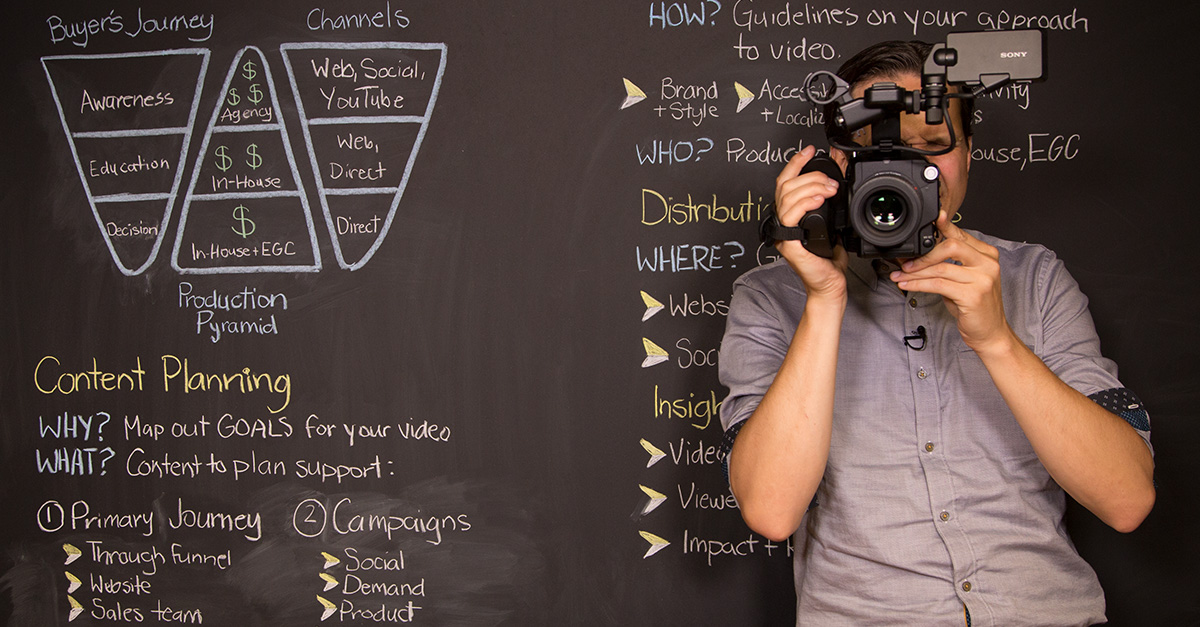They know that it works to engage new audiences, to educate prospects through the buyer’s journey, and to build more personal relationships that help sales teams close more deals. They’re unsure of which channels they should be using to maximize their reach, but also hit the right people with the right message, what types of insights they should be tracking to understand the performance of their videos and what type of content is generating the greatest ROI. So how do you go about developing a video strategy? It comes down to a few main areas, and the first is developing a content plan. This usually aligns back up to higher order business goals, whether it’s increasing brand awareness, generating more leads in pipeline, increasing customer retention, or maybe a mix of all of those. Once you understand that, you’ll want to start to develop a plan for what you’re going to create as a team, and in order to do that, you’ll want to think about two distinct types of videos. So again, you may not have all the answers up front, but developing a model for understanding who’s going to take responsibility for producing different types of content is a super-important part of developing a video strategy. So better understanding of who’s watching my videos, how long they’re engaging in each video, and am I going to use those insights in my marketing and sales programs. So this starts to give you a map for how to create a video strategy that helps make sure you’re taking a more strategic approach to the content you’re creating, the channels you’re using, and the insights you’re gathering so you can ensure you’re making the best use of your resources and delivering video in a way that’s going to have a real business impact. To help you get started with that, we’ve created the Video Strategy Workbook, which takes you through the 9 simple steps to creating a video strategy, from setting goals around your video content, all the way through to measuring success, and organizing your team around creating great video.
Most businesses are investing in video as a way to improve marketing and sales performance and deliver a better customer experience. Yet most companies are still taking a reactive approach to video production instead of a proactive approach to a video strategy.
My name is Tyler Lessard, and in this Chalk Talk, we’ll explore why you should develop a video strategy and how to do it in a way that aligns with your business goals. Most marketing and sales teams that I speak with understand the inherent value in video content. They know that it works to engage new audiences, to educate prospects through the buyer’s journey, and to build more personal relationships that help sales teams close more deals.
|
|
But what they don’t understand is how to take a more strategic approach to what type of content they should be using at each stage of the buyer’s journey and how they’re going to expand their ability to produce great content without inflating their budgets. They’re unsure of which channels they should be using to maximize their reach, but also hit the right people with the right message, what types of insights they should be tracking to understand the performance of their videos and what type of content is generating the greatest ROI. Building a video strategy is all about building a plan and a map for the right content through the right channels with the right insights so you know that you’re getting the biggest bang for your buck and getting the most value out of video.
So how do you go about developing a video strategy? It comes down to a few main areas, and the first is developing a content plan. This is where you’ll want to look at why am you are developing video and make sure that’s understood within your team. What are the goals? This usually aligns back up to higher order business goals, whether it’s increasing brand awareness, generating more leads in pipeline, increasing customer retention, or maybe a mix of all of those. This should be clear from day one so that the kinds of videos that you’re producing always ladder back to those higher order business goals.
Once you understand that, you’ll want to start to develop a plan for what you’re going to create as a team, and in order to do that, you’ll want to think about two distinct types of videos. One are the sets of videos that are going to support your primary buyer’s journey. So no matter what else comes up on a daily basis, these are the core videos you need to better engage your audience and build more efficiency in your marketing and sales processes. To do this, you’ll want to do a needs and gap analysis on the buyer’s journey and the sales funnel. What videos do we have at each stage? And, where are there gaps that we need to fill to make sure we can offer a video journey for those audiences that want to take that path?
Secondly is looking at your website and where are there gaps where video content could help you increase conversion rates or tell a better story. And finally, what are the videos your sales teams need to be more effective in the closing cycle of new deals? Customer testimonials, product demos, and so on.
Once you understand your requirements across these, you can develop a pretty specific plan for what videos you need to build for the next three, six, or 12 months to help you in that primary buyer’s journey to be more effective.
Planning for the Unplanned
Now, we all know that things come up, and there’s campaigns and product launches and press releases that video may need to support. You can’t plan ahead on all of those, but what you can do is develop a set…

COMMENTS